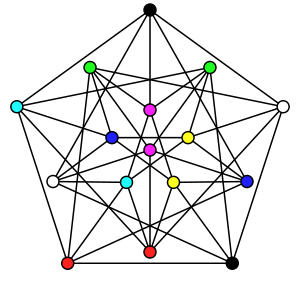Complete coloring
In graph theory, complete coloring is the opposite of harmonious coloring in the sense that it is a vertex coloring in which every pair of colors appears on at least one pair of adjacent vertices. Equivalently, a complete coloring is minimal in the sense that it cannot be transformed into a proper coloring with fewer colors by merging pairs of color classes. The achromatic number ψ(G) of a graph G is the maximum number of colors possible in any complete coloring of G.

Complexity theory
Finding ψ(G) is an optimization problem. The decision problem for complete coloring can be phrased as:
- INSTANCE: a graph and positive integer
- QUESTION: does there exist a partition of into or more disjoint sets such that each is an independent set for and such that for each pair of distinct sets is not an independent set.
Determining the achromatic number is NP-hard; determining if it is greater than a given number is NP-complete, as shown by Yannakakis and Gavril in 1978 by transformation from the minimum maximal matching problem.[1]
Note that any coloring of a graph with the minimum number of colors must be a complete coloring, so minimizing the number of colors in a complete coloring is just a restatement of the standard graph coloring problem.
Algorithms
For any fixed k, it is possible to determine whether the achromatic number of a given graph is at least k, in linear time.[2]
The optimization problem permits approximation and is approximable within a approximation ratio.[3]
Special classes of graphs
The NP-completeness of the achromatic number problem holds also for some special classes of graphs: bipartite graphs,[2] complements of bipartite graphs (that is, graphs having no independent set of more than two vertices),[1] cographs and interval graphs,[4] and even for trees.[5]
For complements of trees, the achromatic number can be computed in polynomial time.[6] For trees, it can be approximated to within a constant factor.[3]
The achromatic number of an n-dimensional hypercube graph is known to be proportional to , but the constant of proportionality is not known precisely.[7]
References
- Michael R. Garey and David S. Johnson (1979), Computers and Intractability: A Guide to the Theory of NP-Completeness, W.H. Freeman, ISBN 978-0-7167-1045-5 A1.1: GT5, pg.191.
- Farber, M.; Hahn, G.; Hell, P.; Miller, D. J. (1986), "Concerning the achromatic number of graphs", Journal of Combinatorial Theory, Series B, 40 (1): 21–39, doi:10.1016/0095-8956(86)90062-6.
- Chaudhary, Amitabh; Vishwanathan, Sundar (2001), "Approximation algorithms for the achromatic number", Journal of Algorithms, 41 (2): 404–416, CiteSeerX 10.1.1.1.5562, doi:10.1006/jagm.2001.1192.
- Bodlaender, H. (1989), "Achromatic number is NP-complete for cographs and interval graphs", Inf. Process. Lett., 31 (3): 135–138, doi:10.1016/0020-0190(89)90221-4.
- Manlove, D.; McDiarmid, C. (1995), "The complexity of harmonious coloring for trees", Discrete Applied Mathematics, 57 (2–3): 133–144, doi:10.1016/0166-218X(94)00100-R.
- Yannakakis, M.; Gavril, F. (1980), "Edge dominating sets in graphs", SIAM Journal on Applied Mathematics, 38 (3): 364–372, doi:10.1137/0138030.
- Roichman, Y. (2000), "On the Achromatic Number of Hypercubes", Journal of Combinatorial Theory, Series B, 79 (2): 177–182, doi:10.1006/jctb.2000.1955.